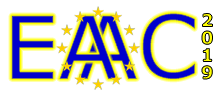Speaker
Description
Three dimensional Particle in Cell simulations of Laser Wakefield Acceleration require a considerable amount of resources but are necessary to have realistic predictions and to design future experiments. The planned experiments for the CILEX facility also include two stages of plasma acceleration, for a total plasma length of the order of centimiters. In this context, where traditional 3D simulations would be infeasible, we present the results of the application of a recently developed explicit 3D envelope method [1]. This model describes the laser pulse ant its self-consistent interaction with the plasma without the need to resolve its high frequency oscillations, considerably reducing the computation time. The implementation of this envelope model in the code Smilei will be described, as well as the results of benchmark simulations against standard simulations and its applications for the design of two stage CILEX experiments.
[1] D. Terzani and P. Londrillo, A fast and accurate numerical implementation of the envelope model for laser–plasma dynamics, Computer Physics Communications (2019), https://doi.org/10.1016/j.cpc.2019.04.007

